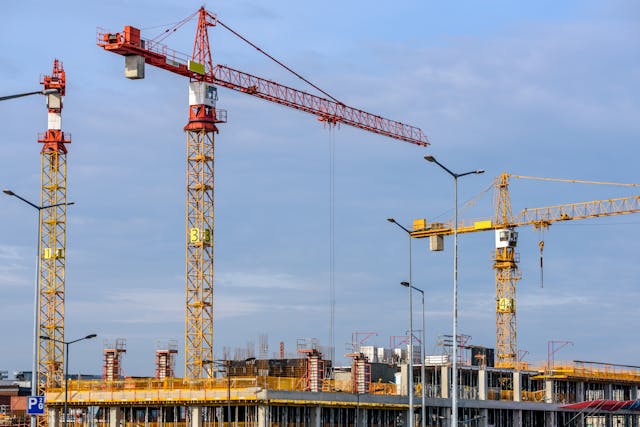Constructing a 10,000 sq ft commercial building typically costs between 1 million and 3 million, depending on materials, labor, and location. Key factors include design complexity, permits, and utility setup. Prefab wall panels offer a cost-effective solution, reducing both expenses and construction time. These elements play a critical role in determining the overall budget and timeline for large-scale projects.
Table of Contents
- Factors Influencing Commercial Building Costs
- Breaking Down the Costs of a 10,000 Sq Ft Commercial Building
- How to Optimize Building Costs Without Sacrificing Quality
- Final Thoughts: Planning for a Successful Commercial Build
Building a commercial space is a significant investment that requires careful planning and a clear understanding of costs. Whether you’re constructing a retail outlet, office building, or industrial facility, knowing what influences expenses can help you make informed decisions. Factors such as materials, labor, location, and design complexity all contribute to the overall budget for a 10,000 sq ft project.
For businesses seeking cost-effective solutions, partnering with a prefab wall panel manufacturer can make a substantial difference. Systems produced by them are designed to reduce construction time while maintaining durability and quality, offering an efficient alternative to traditional building methods. By leveraging innovative materials and techniques, you can optimize both costs and timelines without compromising on performance.
With the right approach, creating a functional and sustainable commercial space is within reach, even in today’s competitive market.
Factors Influencing Commercial Building Costs
Constructing a 10,000 sq ft commercial building involves numerous variables that impact the overall cost. Understanding these factors is essential for creating a realistic budget and timeline. Below are key elements that play a significant role in determining expenses:
Material Costs
The choice of materials directly affects both the upfront costs and long-term durability of the building. For instance:
- Traditional Materials. Concrete and steel remain popular but can be expensive due to fluctuating market prices.
- Innovative Solutions. Prefabricated systems, such as wall panels, offer cost savings while maintaining structural integrity.
Labor Costs
Labor is one of the largest expenses in commercial construction. Key considerations include:
- Skilled Workforce. Hiring experienced professionals secures quality but may increase costs.
- Project Timeline. Delays or inefficiencies can lead to higher labor expenses over time.
Location and Site Conditions
The geographical location of the project also influences costs:
- Urban vs. Rural. Building in urban areas often incurs higher land and labor costs.
- Site Accessibility. Challenging terrains or limited access can require additional resources.
Regulatory and Design Requirements
Permits, zoning laws, and design specifications add complexity:
- Permits and Fees. Compliance with local regulations can be costly and time-consuming.
- Custom Designs. Unique layouts or features may increase material and labor needs.
By addressing these factors early in the planning process, you can better anticipate costs and avoid unexpected challenges.
Breaking Down the Costs of a 10,000 Sq Ft Commercial Building
Understanding the costs involved in constructing a 10,000 sq ft commercial building is crucial for effective budgeting and planning. Below, we break down the primary cost categories and provide actionable insights to help you make informed decisions.
Material Costs: The Foundation of Your Budget
Materials are one of the largest expenses in commercial construction. Here’s how they impact your budget:
- Traditional Materials (Concrete, Steel).
Widely used but subject to price fluctuations, these materials can significantly increase upfront costs. - Prefab Wall Panels.
These systems offer a modern alternative, reducing material waste and promoting faster installation. Key benefits include:- Lower production costs due to factory-based manufacturing.
- Enhanced durability and weather resistance.
- Eco-friendly options that align with sustainability goals.
Compared to traditional methods, prefabricated materials are considered to significantly reduce construction time (up to 50%). By opting for innovative solutions like prefab systems, you can achieve significant savings while maintaining high-quality standards.
Labor Costs: Managing Workforce Expenses
Labor accounts for a substantial portion of construction budgets, and managing these costs requires careful planning. Consider the following:
- Skilled Labor Rates.
Experienced workers are essential for delivering quality results, but rates vary by region. Urban areas often see higher labor costs compared to rural locations. - Efficiency Through Prefabrication.
Prefab components reduce on-site assembly time, minimizing labor hours and associated expenses. - Avoiding Delays.
Poor planning or unforeseen challenges can extend timelines, increasing labor costs. Partnering with reliable contractors helps mitigate risks.
Streamlining labor processes supports better cost control and timely project completion.
Additional Costs: Beyond Materials and Labor
Several other factors contribute to the total cost of a commercial build. These include:
- Permits and Regulatory Fees.
Navigating local regulations and obtaining necessary approvals can be costly and time-consuming. - Design Complexity.
Custom layouts or intricate architectural features may require specialized expertise and materials, driving up expenses. - Utility Setup.
Installing electrical, plumbing, and HVAC systems adds to the overall investment, especially for larger spaces.
Addressing these elements early in the planning process helps prevent unexpected costs and promotes a smoother construction phase.
Key Takeaways for Cost Optimization
To summarize, here are the main strategies for managing costs effectively:
- Prioritize materials that balance affordability and performance, such as prefab wall panels.
- Streamline labor through efficient planning and prefabrication techniques.
- Account for additional expenses like permits, design fees, and utility setup from the outset.
A well-planned approach not only reduces costs but also fosters long-term value for your commercial space.
How to Optimize Building Costs Without Sacrificing Quality
Building a 10,000 sq ft commercial space involves careful planning and smart decision-making. To help you maximize value while staying within budget, here are some actionable strategies that focus on efficiency, collaboration, and long-term benefits.
Leverage Technology for Smarter Construction
Modern tools and innovative materials can significantly enhance the construction process. Here are a few ways to integrate technology effectively:
- Use 3D modeling software to minimize design errors and rework during construction.
- Incorporate prefab wall panels to reduce material waste and installation time.
- Install energy-efficient systems like LED lighting and high-performance HVAC units.
By adopting advanced solutions, you create a foundation for cost-effective and sustainable construction.
Collaborate with Skilled Professionals
Working with experts is one of the most effective ways to achieve a smooth and successful project. While managing costs is important, partnering with experienced professionals can prevent costly mistakes and delays. Consider these steps:
- Consult architects to align designs with structural requirements and budget constraints.
- Work with contractors who specialize in large-scale commercial projects.
- Engage manufacturers specializing in durable, cost-effective systems.
Early collaboration fosters a cohesive plan that supports both affordability and quality.
Prioritize Long-Term Value Over Short-Term Savings
Focusing on durability and adaptability ensures your building remains functional for years to come. Here’s how to prioritize long-term benefits:
- Select low-maintenance materials to reduce repair and upkeep costs over time.
- Design flexible layouts that accommodate future expansions or changes in business needs.
- Incorporate eco-friendly practices to appeal to modern tenants and customers.
Investing in sustainable and adaptable solutions promotes resilience and reduces lifecycle expenses.
Final Thoughts: Planning for a Successful Commercial Build
Constructing a 10,000 sq ft commercial building is a complex yet rewarding endeavor. By understanding the key cost drivers – such as materials, labor, and additional expenses – you can create a realistic budget and timeline. Innovations like prefab wall panels offer significant advantages, reducing both costs and construction time while maintaining durability and sustainability.
Partnering with skilled professionals helps align your project with structural requirements and long-term goals. Additionally, prioritizing energy-efficient systems and adaptable designs supports resilience and value for years to come. With thoughtful planning and informed decisions, you can build a commercial space that meets your needs while staying within budget.

